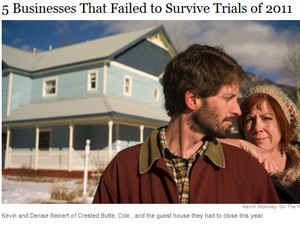For The New York Times, freelancer Eilene Zimmerman produced a quick-hit look at five businesses that failed in 2011. It’s a story that could be replicated in any geography.
Eilene tells us about a decorative-molding business in Maryland; a loan company and a dog-food business in New York; a bed-and-breakfast in Colorado; and an online training program in California. For each failed business, she tells their stories in these categories: “at their peak,” “what went wrong” and “looking back.”
To get this information, she didn’t use a questionnaire, she says.
“I knew the key information I needed and made sure to get that,” Eilene says. “With these kinds of profiles, even though they are short, I always want to know the entire story so I can put it into some context and can really understand the specific situation.”
Today’s Tip: Add online resources such as Help a Reporter Out (HARO) and ProfNet to your source-hunting tools.
Founded in 2008 by entrepreneur Peter Shankman, HARO’s website says: “Tap into the largest source repository in the world with over 80,000 mainstreet and expert sources who will respond directly to your query on your terms.” HARO is also on Twitter @helpareporter.
ProfNet, which is part of PR Newswire, bills itself as connecting reporters promptly with experts within “an online community of nearly 27,000 corporate, university and other communicators.” It’s been around since 1992 and is on Twitter @ProfNet.
As noted in my previous post about Boston Globe reporter Meghan E. Irons’ piece on “check day” in a poor neighborhood, sometimes you have to overcome hurdles to find people willing to talk.
“It’s often very painful for business owners to talk about a venture that failed, especially when they’ve invested so much of themselves in it,” Eilene says.
Aside from the basics of talking with non-journalism friends and asking fellow writers, freelancers, editors, Eilene says she also put out queries on HARO and Profnet. “I had to do that about four times, actually,” she says.
She posted requests on Facebook and tweeted a request twice.
She read stories online about failed businesses in different industries. She got leads about the closings of restaurants, small manufacturing plants and mom-and-pop stores, but she still had to work her way through that list to find business owners willing to talk.








